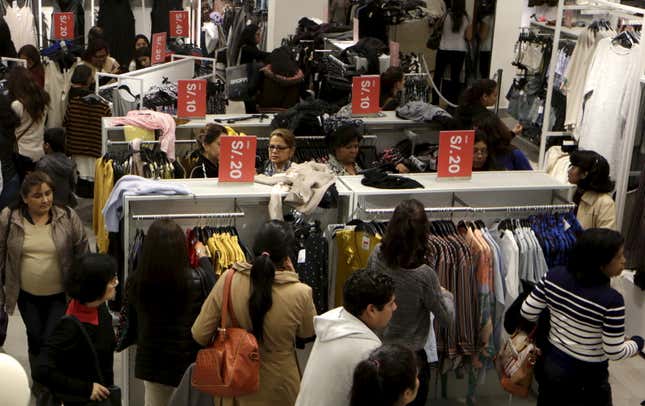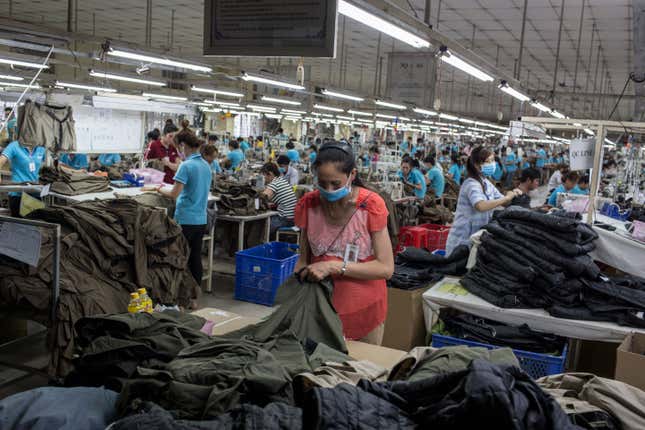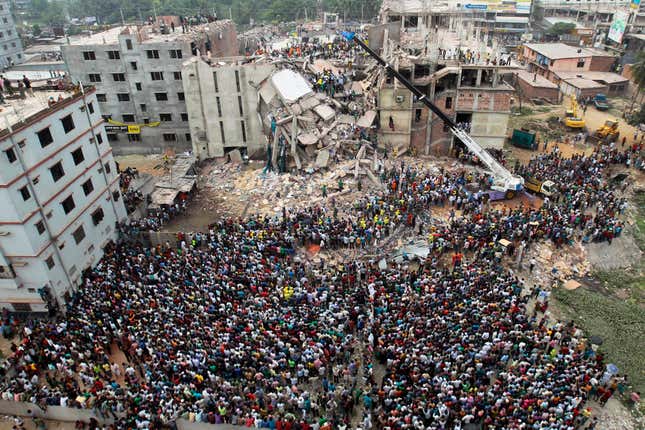The global economy is unbalanced, warns Oxfam.
More and more wealth is concentrated in the hands of an ultra-rich few, while millions below them struggle daily to survive on poverty-level wages. One way to understand the size of the discrepancy: it takes a CEO from one of the world’s top five fashion brands just four days to earn the same amount a Bangladeshi garment worker will earn over her lifetime, Oxfam says in a new report.
Titled “Reward Work, Not Wealth” and timed to the World Economic Forum’s annual gathering of the global elite in Davos, Switzerland, the report examines the huge and growing chasm between the world’s rich and poor. It includes several examples of this dichotomy at work, though few are as pronounced as the international garment industry.
Rich and poor, linked by cheap clothes
Cheap fast fashion has made some of the richest men on the planet, while relying on some of the world’s lowest-paid workers, most of whom are women. In Bangladesh, for instance, about 80% of garment workers are women, frequently working in order to feed their families.
Anju, one woman described in Oxfam’s report, makes just over $900 a year sewing clothes in Bangladesh. She often works 12 hour days, and has to skip meals because she doesn’t have the money to eat.
Another Bangladeshi woman cited in the report works as a sewing-machine operator in a factory that supplies brands including H&M, Target Australia, and others. For a month in 2016, she worked until midnight every work day, and then would return home to care for her son, only to get up at 5:30am the next day to go back to work. Her wages were still so low that even combined with her husband’s income, the family could only occasionally afford vegetables and chicken, and mostly ate watery rice seasoned with chili and salt.
These scenarios repeat across other countries in the region, such as Vietnam and Cambodia, and wages can be even lower for informal workers, who often do tasks for international brands in their homes.

Meanwhile, in 2017, Stefan Persson, chairman of H&M, earned €658 million (about $809 million) in share dividends. As of this writing, Forbes lists his net worth as $18.1 billion.
Amancio Ortega, founder of Inditex—the parent company of Zara, another fast-fashion brand that manufactures a portion of its clothes in the region—earned approximately €1.3 billion in share dividends in 2016 (about $1.37 billion at the time). Forbes lists his fortune as of this writing at $77.4 billion. For a brief moment in 2015, Ortega overtook Bill Gates as the world’s richest person.
Reluctance to share the wealth
Raising the pay of garment workers to a living wage is theoretically feasible. “It would cost $2.2 billion a year to increase the wages of all 2.5 million Vietnamese garment workers from the average wage to a living wage,” Oxfam writes. “This is the equivalent of a third of the amount paid out to shareholders by the top five companies in the garment sector.”
Of course, that’s just Vietnam. There are millions of low-wage garment workers across Cambodia, Thailand, India, and other countries.

Brands also want to please their shareholders, which means keeping costs low and profits high. But Oxfam’s point is that the wealth gap shouldn’t be—and doesn’t have to be—as great as it is. H&M, for one, has publicly committed to paying a living wage to workers in its supplier factories, though the Clean Clothes Campaign, a watchdog group, has accused it of not adequately following through on that promise.
Many garment workers also face unsafe conditions in factories. The severity of this problem was brought to public attention by the 2013 Rana Plaza factory collapse in Bangladesh that killed some 1,134 people.

Global brands can make huge amounts of money by producing cheap clothes in these factories, but at times have been reluctant to fund safety improvements that could cut into profits. Generally they don’t own the factories themselves, but rather contract independent suppliers to do the work. The actual factory owners, who don’t always want to spend money either, often complain that brands use their leverage to drive down prices, and then don’t rush to contribute to the safety-improvement process, leaving a funding gap.
It’s daunting and expensive to fix an entire industry, especially one built haphazardly like Bangladesh’s garment sector. That said, the cost isn’t necessarily out of reach. A 2016 report by the International Labour Organization and International Finance Corporation estimated that the total cost to remediate 3,778 factories—not the whole of the industry, but a significant portion nonetheless—from scratch after Rana Plaza would have been roughly $929 million (pdf, p.24). The amount includes all factories covered by the Accord and Alliance—two highly publicized agreements among multinational brands, labor unions, and other invested groups organized after the Rana Plaza collapse to remediate Bangladesh’s garment industry—and factories that are part of the National Initiative, a Bangladesh-driven plan to improve industry standards.
H&M, one of Bangladesh’s garment industry’s biggest clients, recorded about $2 billion in profit in 2016. And that’s just one company.
The gap is still growing
The world has undoubtedly made major strides in reducing extreme poverty, in part through grueling yet vital low-wage jobs like those held by garment workers. But inequality continues to grow: Oxfam notes that last year saw the biggest increase in the number of billionaires in history, and also saw huge increases in billionaires’ wealth. “This increase was enough to end extreme poverty seven times over,” Oxfam says. “Eighty-two percent of all of the growth in global wealth in the last year went to the top 1%, whereas the bottom 50% saw no increase at all.”
The resulting imbalance affects garment workers as well as people who spend their days assembling electronics, small-scale farmers, and countless others. Yet you wouldn’t spot this disparity from looking at traditional measures of the global economy. In 2017, more countries were recording GDP growth than at any time since 2007, just before the financial crisis.
Oxfam insists that it is possible to fix the problem, though it wouldn’t be easy. It proposes abandoning “dogmatic adherence to neoliberal economics and the unacceptable influence of elites on our governments,” and using taxes and public spending to effectively redistribute wealth. It also suggests redesigning our economies so the ultra-rich don’t continue to take home a disproportionate share of any gains. In other words, reward work, not wealth. If we could do that at a global scale, perhaps fewer factory workers would go hungry, while building up the immense fortunes of multinational corporations and their shareholders.
